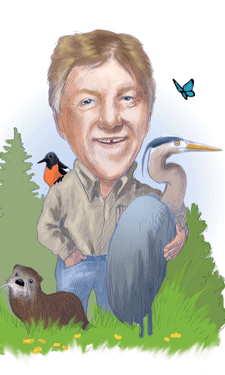 If you’re a regular reader of Parks & Recreation magazine, the subject of this month’s Staff Spotlight is sure to ring a bell. Richard Dolesh, NRPA’s vice president of conservation and parks, is our go-to guy when it comes to the history, trends and of-the-moment concerns of the park and recreation profession. His career as a naturalist, educator and advocate spans more than four decades, but his love of nature and staunch belief that parks and recreation should play a major role in our day-to-day lives has been cultivated over a lifetime. Dolesh contributes frequently here as both a feature writer and curator of our Conservation pillar column, so we were extremely pleased to corral him for a more personal chat about his career and what he predicts for the future of the field.
If you’re a regular reader of Parks & Recreation magazine, the subject of this month’s Staff Spotlight is sure to ring a bell. Richard Dolesh, NRPA’s vice president of conservation and parks, is our go-to guy when it comes to the history, trends and of-the-moment concerns of the park and recreation profession. His career as a naturalist, educator and advocate spans more than four decades, but his love of nature and staunch belief that parks and recreation should play a major role in our day-to-day lives has been cultivated over a lifetime. Dolesh contributes frequently here as both a feature writer and curator of our Conservation pillar column, so we were extremely pleased to corral him for a more personal chat about his career and what he predicts for the future of the field.
Parks & Recreation magazine: How did you get your start in this profession?
Richard Dolesh: I started out as a middle school teacher, teaching English and science. As a teacher I was poor as a church mouse, so I got a part-time summer job at Patuxent River Park for the Maryland-National Capital Park and Planning Commission (M-NCPPC). I eventually was hired as a park naturalist, worked my way up, and became division chief of M-NCPPC’s Natural and Historic Resources Division. I worked for M-NCPPC for 29 years.
In 1999, I was appointed by the Maryland secretary of natural resources as the director of the state Department of Natural Resources’ Forest, Wildlife and Heritage Service. In 2002, I came to NRPA as a senior public policy associate in our public policy office and was promoted to chief of public policy in 2005. In 2008, I was made vice president for conservation and parks, where I’ve served since.
P&R: Describe your day-to-day activities.
Dolesh: My primary responsibility is to engage park and recreation agencies around the country in conservation at the community level. I also serve as a resource for our members and a voice for the cause of parks.
P&R: The field of parks and recreation has evolved significantly since NRPA’s inception 50 years ago. What do you think are the most notable changes?
Dolesh: The challenges we face are much more serious and the stakes are much higher. When you consider the challenges park agencies face — the loss of open space, declining funding to do our work, impacts of climate change and disconnection of kids from nature — all these are serious things that we have to deal with in order to be successful in the future. If we don’t meet these challenges, we will lose many of the things we really value.
P&R: What current trends do you see having a major impact on our field going forward?
Dolesh: The trends I see are a continuing decline in public funding of parks and the need to create more public-private partnerships to achieve our missions. Technology will be very important in reaching the public — agencies will have to be technologically savvy and go mobile. Perhaps the greatest challenge will be reconnecting kids to nature and the outdoors. We must keep kids connected to nature. They will become the stewards of our parks in the future, and the only way they will care about parks is if they value them.
P&R: What advice would you wish to impart to today’s park and recreation professional?
Dolesh: Be clever, curious and creative. Always have an open mind about alternative and innovative ways to do things, meet challenges and solve problems. And, have a love of nature and the outdoors that lasts a lifetime.
Samantha Bartram is the Associate Editor of Parks & Recreation magazine.

